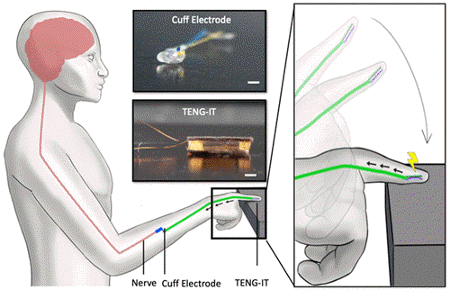Researchers at the Department of Biomedical Engineering, Tel Aviv University, along with collaborators from the Sagol School of Neuroscience, the Sackler School of Medicine, and the Sheba Medical Center in Israel, have invented a tiny sensor that is implantable in a damaged limb which can then be connected directly to the nearest healthy nerve to restore the sensation of touch.
Restoring damaged nerves from an injury is difficult. You cannot easily suture broken nerve ends and make them reconnect. I’ll give you an example from personal experience. I broke my legs in a tobogganing accident when I was in university. After multiple surgeries to rebuild the broken weight-bearing bones of my left limb, my nerves from the mid-point below my knee to the ankle no longer worked. This didn’t impede me from walking but I constantly had to pay attention to bumping into things, or accidentally burning or cutting myself on that leg because I couldn’t feel a thing.
That’s the problem this Israeli team of biomedical engineers and medical doctors decided to tackle. They looked at the most recent research into neural prostheses which use sensors to connect severed nerves. But the existing solutions required external power sources. In other words, a battery.
For restoring the sense of touch in a finger, a battery was seen as impractical. So the research team at Tel Aviv University decided to develop a triboelectric nanogenerator, called a TENG. The TENG could be powered by the body’s own movements and nerves. Connecting it directly to a healthy nerve, therefore, would restore sensation.
The TENG is an implantable piezoelectric sensor powered by natural frictional forces. The sensor consists of two tiny plates, each 0.5 centimetres square. When frictional forces cause them to come into contact an electric charge is transmitted to the connected undamaged nerve. If implanted for an injured finger, the frictional tension can vary based on whether the person is using a firm or weak touch.
The TENG can be implanted anywhere in a body to restore tactile sensation. It is built from biocompatible materials so it is well tolerated. So far the team hasn’t used a human subject. But in test animals, they have used the TENG to restore normal walking despite motor nerve damage. In the near future, TENG sensors will be used in a clinical trial with human patients to restore feeling in their fingers.
States Dr. Ben M. Maoz at Tel Aviv University, “Restoring this ability can significantly improve people’s functioning and quality of life, and more importantly, protect them from danger. People lacking tactile sensation cannot feel if their finger is being crushed, burned or frozen.”
The research and invention are described in a journal article that appeared on June 17, 2021, in ACS Nano. The article is entitled, “Restoring Tactile Sensation Using a Triboelectric Nanogenerator.”















